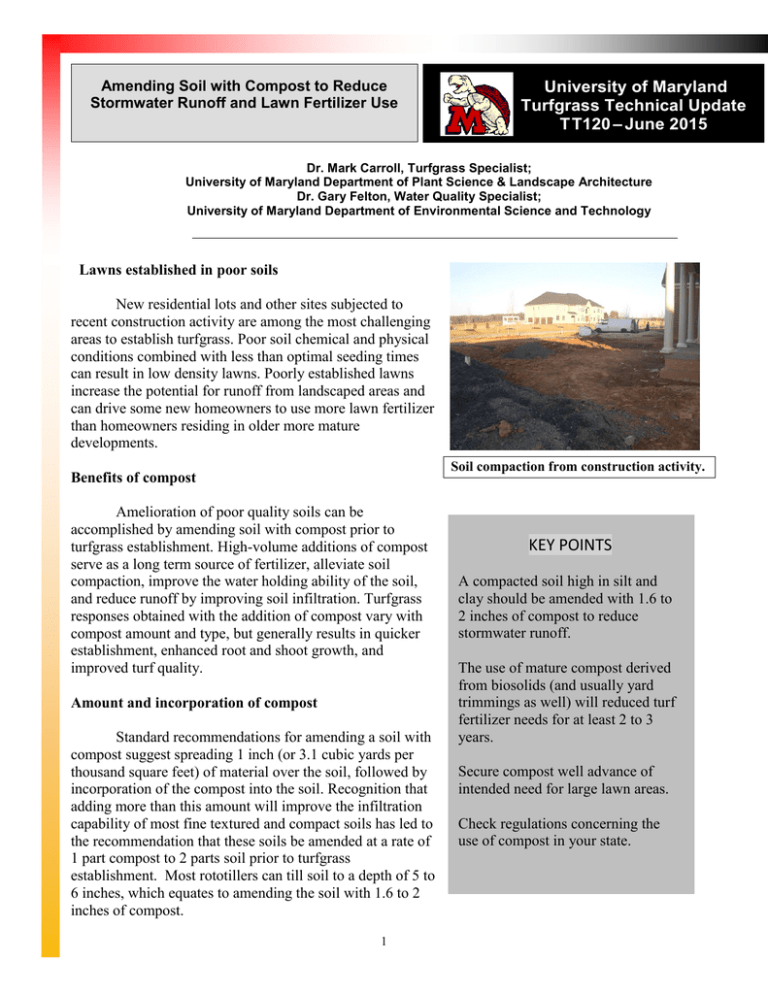University of Maryland Turfgrass Technical Update – T
advertisement

D Amending Soil with Compost to Reduce Stormwater Runoff and Lawn Fertilizer Use University of Maryland Turfgrass Technical Update T T120 – June 2015 Dr. Mark Carroll, Turfgrass Specialist; TT-77 University of Maryland Department of Plant Science & Landscape Architecture Dr. Gary Felton, Water Quality Specialist; University of Maryland Department of Environmental Science and Technology Lawns established in poor soils New residential lots and other sites subjected to recent construction activity are among the most challenging areas to establish turfgrass. Poor soil chemical and physical conditions combined with less than optimal seeding times can result in low density lawns. Poorly established lawns increase the potential for runoff from landscaped areas and can drive some new homeowners to use more lawn fertilizer than homeowners residing in older more mature developments. Soil compaction from construction activity. Benefits of compost Amelioration of poor quality soils can be accomplished by amending soil with compost prior to turfgrass establishment. High-volume additions of compost serve as a long term source of fertilizer, alleviate soil compaction, improve the water holding ability of the soil, and reduce runoff by improving soil infiltration. Turfgrass responses obtained with the addition of compost vary with compost amount and type, but generally results in quicker establishment, enhanced root and shoot growth, and improved turf quality. Amount and incorporation of compost Standard recommendations for amending a soil with compost suggest spreading 1 inch (or 3.1 cubic yards per thousand square feet) of material over the soil, followed by incorporation of the compost into the soil. Recognition that adding more than this amount will improve the infiltration capability of most fine textured and compact soils has led to the recommendation that these soils be amended at a rate of 1 part compost to 2 parts soil prior to turfgrass establishment. Most rototillers can till soil to a depth of 5 to 6 inches, which equates to amending the soil with 1.6 to 2 inches of compost. 1 KEY POINTS A compacted soil high in silt and clay should be amended with 1.6 to 2 inches of compost to reduce stormwater runoff. The use of mature compost derived from biosolids (and usually yard trimmings as well) will reduced turf fertilizer needs for at least 2 to 3 years. Secure compost well advance of intended need for large lawn areas. Check regulations concerning the use of compost in your state. In areas where the lawn will receive runoff from impervious surfaces, such as rooftop downspouts or adjacent paved surfaces, deeper rates of incorporation along with compost additions as high as 40% by volume are recommended. Use of rates above this are not recommended because of concerns about nutrient leaching, excessive turfgrass growth and soil settling. In general, a soil amended with 2 inches of compost down to a depth of 6 inches will drop approximately 3 inches over time as some of the pores within the soil become filled with particles and as the added compost degrades. An allowance for the elevated height of soil recently amended with large amounts of compost needs to be considered when establishing the finished grade around sidewalks, driveways and other impervious surfaces that convey water to the lawn area. Compost can be distributed using manure spreader or by construction equipment used to grade the site. Uniform incorporation of compost into compacted soil is best by achieved by rototilling the soil at least twice. Once before spreading the compost and then again when the material is mixed with the soil. A compacted soil is one in which a shovel or stand pickaxe cannot easily penetrate to the desired depth of incorporation. In non-compacted soils, pre-incorporation tillage of the soil is not necessary. Uniform incorporation of the compost however may require more than one pass depending on the type of equipment that is used to incorporate the compost. Where to amend soil with compost to reduce runoff Runoff reductions of 50% have been observed in soils amended with compost in the year following turfgrass establishment. Runoff reductions may be greater or less than this depending on the texture and state of compaction of the soil. Amending a soil with compost is most effective in reducing runoff from flat to gently sloping sites having compact soils that contain a significant amount of silt and clay. Little to no reduction in runoff should be expected from sandy soils amended with compost; however, leaching losses of water may be reduced. The presence of an impermeable layer or water table within 1.5 feet of the soil surface will moderate the ability of a compost amended soil to reduce runoff, as will sites where the slope exceeds 10%. Some construction practices tend to create or exacerbate such an impermeable layer. Compacted soil layers below normal tillage depths can be overcome by incorporating the use of solid -shank ripper as part of the soil preparation, compost incorporation process. 2 Residential lots that contain a high proportion of impervious surfaces, with most of pervious area consisting of a lawn, are ideal lots to amend with compost prior to turfgrass establishment. Large lots containing a low portion of impervious surface and non-compacted soil already have properties that favor reduced runoff. In the case of the latter, the reduction in runoff seen with amending soil with compost, together with large volume of compost required to treat such yards, may not warrant the use of this practice. Compost to reduce fertilizer use The principal long-term nutritional benefit to turfgrass from compost incorporation into soil is nitrogen (N). The availability of N in compost is dependent on source from which the compost was derived. Compost derived from sewage sludge (i.e. biosolids) are richer in N than composts created from yards trimmings and municipal waste. For example, biosolid compost from Baltimore contains about 2.8% N while a widely available suburban Maryland compost created from yard trimmings contains about half this amount. Compost containing a high amount of wood chips or compost derived from a high proportion paper based products initially has little nitrogen available for uptake. These types of compost typically have a carbon to nitrogen (C:N) ratios greater than 25 and require the addition of nitrogen during turfgrass establishment. Compost having a C:N ratio less than 25, when spread to a 2 inch depth prior to incorporation, typically provide enough readily available N that no additional N fertilizer is required during establishment and up to a turf age of 2 to 3 years. After this time, compost amended soil will typically require less nitrogen fertilizer than noncompost amended soil to maintain similar levels of turf quality and density. Turfgrass fertilizer needs should be based on visual monitoring of turf quality and made in compliance with nutrient management and turf fertilizer laws within the state. Currently the State of Maryland treats compost as a fertilizer source. This preempts using more than 1/8 inch of compost as a soil amendment when conventional tillage practices are used to prepare the seedbed. If ripping, or other deep tillage practices are employed to breakup impermeable subsoil layers, it is permissible to incorporate high volume amounts of compost into the soil in Maryland. In the states of Virginia and Pennsylvania, the use compost as a soil amendment is viewed as a best stormwater management practice to reduce runoff and the higher recommended rates may be used. Obtaining compost The amount of compost needed to amend a soil to reduce runoff is substantial and usually necessitates that the material be delivered in bulk form (i.e., not bagged). Municipal and large-scale commercial compost facilities produce compost in sufficient quantities to supply the amounts needed for most projects. These operations have quality control procedures in place to insure the compost is stabilized and free of objectionable odors, weed seeds and chemical and biological contaminates that may be of concern to mammalian and plant health. Large volume production compost facilities often restrict sales to commercial accounts only. For large projects (i.e., > 100 cubic yards) the compost will need to be ordered well in advance of the intended date of use. A walking floor tractor trailer, which holds 35 to 40 cubic yards, is often used to deliver compost to large job sites. 3 Expected costs Lawn establishment in new residential lots typically consists of lightly scarifying the soil surface, before broadcasting the seed and covering it with straw or a hydromulch product. Amending a soil with compost adds the material cost of the compost and the labor and equipment costs associated spreading and incorporating this material into the soil. In Metropolitan Washington DC a landscape contractor will typically charge around $2700 to seed a 5000 ft2 area amended with 2 inches of compost to a depth of 4 to 5 inches. Hydroseeding the same area without amending the soil with compost will cost approximately $800. In situations where equipment access to the yard may be restricted the cost spreading and incorporating the compost would likely be higher. The initial costs of compost incorporation into soil, however, may be somewhat offset by the reduction in the need for future fertilizer applications in addition to the environmental benefits associated with reductions in stormwater runoff. References Barker, A.V. 2001 Compost utilization in sod production and turf management. In P.J. Stoffella and B.A Kahn (ed.) p 201-224. Compost Utilization in Horticultural Cropping Systems. Ann Arbor Press Cholla, T and P. Rosenfeld. 1998. Guidelines for landscaping with compost-amended soils. Report to City of Redmond Public Works. Redmond, WA. Available at http://depts.washington.edu/cwws Cogger C.G. 2005. Potential compost benefits for restoration of soils disturbed by urban development. Compost Sci. and Utilization 13:243-251. Landschoot, P. and A. McNitt. Improving turf with compost. 1994. Biocycle. 35:55-57. Pennsylvania Stormwater Best Management Practices Manual. 2006. Restoration BMPs, BMP 6.7.3 Soil Amendment & Restoration. Virginia Department of Conservation and Recreation (VA-DRC). 2013. Virginia DCR Stormwater Design Specification No. 4: Soil Compost Amendment Version 2.0. Acknowledgement Funding to support the creation of this document was received from National Fish and Wildlife Foundation Chesapeake Bay Stewardship Fund Innovative Nutrient and Sediment Reduction program. Educating People to Help Themselves Local Governments U.S. Department of Agriculture Cooperating The University of Maryland is equal opportunity. The University’s policies, programs and activities are in conformance with pertinent Federal and State laws and regulations on nondiscrimination regarding race, color, religion, age, national origin, sex, and disability. Inquiries regarding compliance with Title VI of the Civil Rights Act of 1964, as amended; Title IX of the Educational Amendments; Section 504 of the Rehabilitation Act of 1973; and the Americans With Disabilities Act of 1990; or related legal requirements should be directed to the Director of Personnel/Human Relations, Office of the Dean, College of Agriculture and Natural Resources, Symons Hall, College Park, MD 20742. 4




